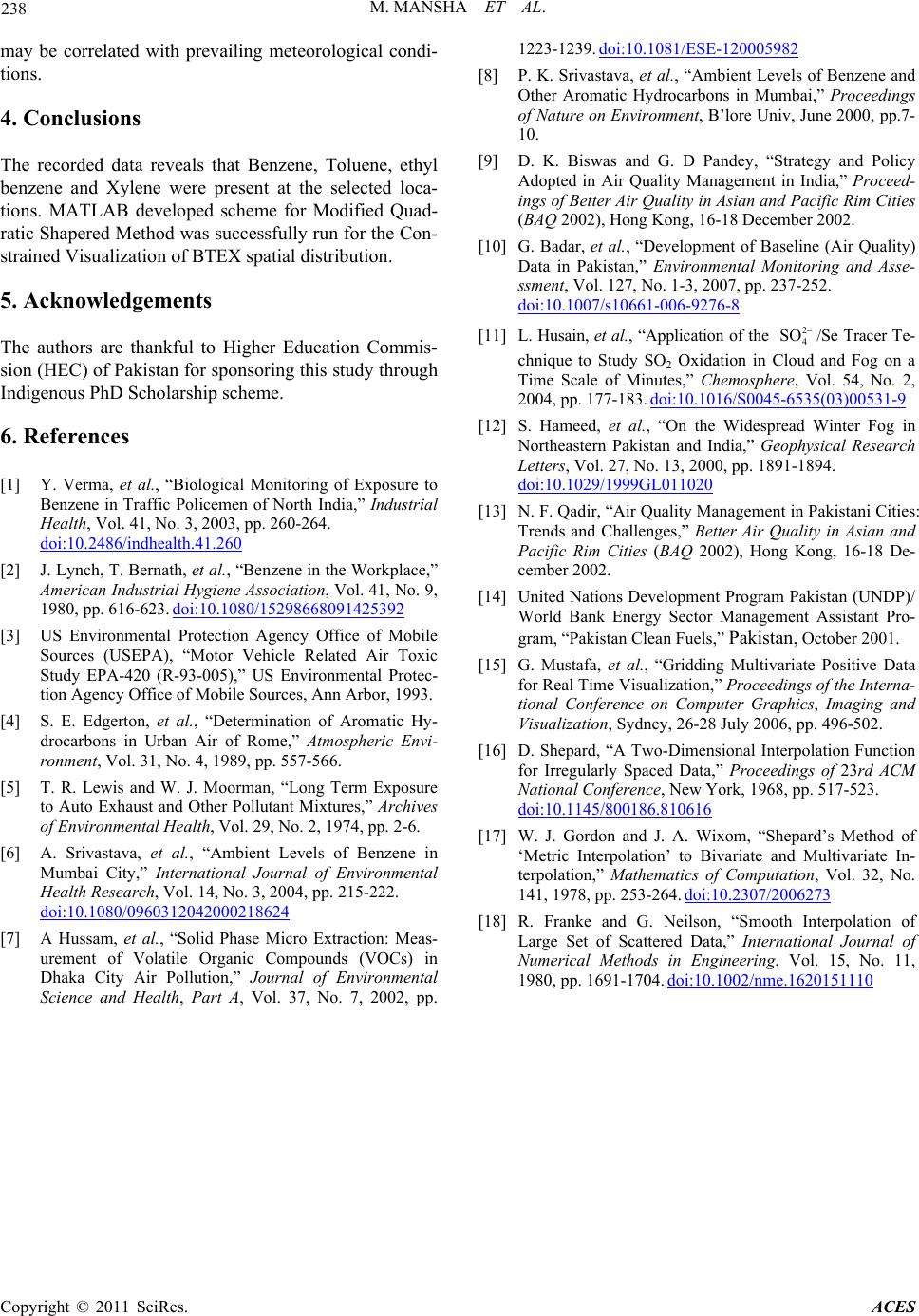
238 M. MANSHA ET AL.
may be correlated with prevailing meteorological condi-
tions.
4. Conclusions
The recorded data reveals that Benzene, Toluene, ethyl
benzene and Xylene were present at the selected loca-
tions. MATLAB developed scheme for Modified Quad-
ratic Shapered Method was successfully run for the Con-
strained Visualization of BTEX spatial distribution.
5. Acknowledgements
The authors are thankful to Higher Education Commis-
sion (HEC) of Pakistan for sponsoring this study through
Indigenous PhD Scholarship scheme.
6. References
[1] Y. Verma, et al., “Biological Monitoring of Exposure to
Benzene in Traffic Policemen of North India,” Industrial
Health, Vol. 41, No. 3, 2003, pp. 260-264.
doi:10.2486/indhealth.41.260
[2] J. Lynch, T. Bernath, et al., “Benzene in the Workplace,”
American Industrial Hygiene Association, Vol. 41, No. 9,
1980, pp. 616-623. doi:10.1080/15298668091425392
[3] US Environmental Protection Agency Office of Mobile
Sources (USEPA), “Motor Vehicle Related Air Toxic
Study EPA-420 (R-93-005),” US Environmental Protec-
tion Agency Office of Mobile Sources, Ann Arbor, 1993.
[4] S. E. Edgerton, et al., “Determination of Aromatic Hy-
drocarbons in Urban Air of Rome,” Atmospheric Envi-
ronment, Vol. 31, No. 4, 1989, pp. 557-566.
[5] T. R. Lewis and W. J. Moorman, “Long Term Exposure
to Auto Exhaust and Other Pollutant Mixtures,” Archives
of Environmental Health, Vol. 29, No. 2, 1974, pp. 2-6.
[6] A. Srivastava, et al., “Ambient Levels of Benzene in
Mumbai City,” International Journal of Environmental
Health Research, Vol. 14, No. 3, 2004, pp. 215-222.
doi:10.1080/0960312042000218624
[7] A Hussam, et al., “Solid Phase Micro Extraction: Meas-
urement of Volatile Organic Compounds (VOCs) in
Dhaka City Air Pollution,” Journal of Environmental
Science and Health, Part A, Vol. 37, No. 7, 2002, pp.
1223-1239. doi:10.1081/ESE-120005982
[8] P. K. Srivastava, et al., “Ambient Levels of Benzene and
Other Aromatic Hydrocarbons in Mumbai,” Proceedings
of Nature on Environment, B’lore Univ, June 2000, pp.7-
10.
[9] D. K. Biswas and G. D Pandey, “Strategy and Policy
Adopted in Air Quality Management in India,” Proceed-
ings of Better Air Quality in Asian and Pacific Rim Cities
(BAQ 2002), Hong Kong, 16-18 December 2002.
[10] G. Badar, et al., “Development of Baseline (Air Quality)
Data in Pakistan,” Environmental Monitoring and Asse-
ssment, Vol. 127, No. 1-3, 2007, pp. 237-252.
doi:10.1007/s10661-006-9276-8
[11] L. Husain, et al., “Application of the 2
4
SO /Se Tracer Te-
chnique to Study SO2 Oxidation in Cloud and Fog on a
Time Scale of Minutes,” Chemosphere, Vol. 54, No. 2,
2004, pp. 177-183. doi:10.1016/S0045-6535(03)00531-9
[12] S. Hameed, et al., “On the Widespread Winter Fog in
Northeastern Pakistan and India,” Geophysical Research
Letters, Vol. 27, No. 13, 2000, pp. 1891-1894.
doi:10.1029/1999GL011020
[13] N. F. Qadir, “Air Quality Management in Pakistani Cities:
Trends and Challenges,” Better Air Quality in Asian and
Pacific Rim Cities (BAQ 2002), Hong Kong, 16-18 De-
cember 2002.
[14] United Nations Development Program Pakistan (UNDP)/
World Bank Energy Sector Management Assistant Pro-
gram, “Pakistan Clean Fuels,” Pakistan, October 2001.
[15] G. Mustafa, et al., “Gridding Multivariate Positive Data
for Real Time Visualization,” Proceedings of the Interna-
tional Conference on Computer Graphics, Imaging and
Visualization, Sydney, 26-28 July 2006, pp. 496-502.
[16] D. Shepard, “A Two-Dimensional Interpolation Function
for Irregularly Spaced Data,” Proceedings of 23rd ACM
National Conference, New York, 1968, pp. 517-523.
doi:10.1145/800186.810616
[17] W. J. Gordon and J. A. Wixom, “Shepard’s Method of
‘Metric Interpolation’ to Bivariate and Multivariate In-
terpolation,” Mathematics of Computation, Vol. 32, No.
141, 1978, pp. 253-264. doi:10.2307/2006273
[18] R. Franke and G. Neilson, “Smooth Interpolation of
Large Set of Scattered Data,” International Journal of
Numerical Methods in Engineering, Vol. 15, No. 11,
1980, pp. 1691-1704. doi:10.1002/nme.1620151110
Copyright © 2011 SciRes. ACES